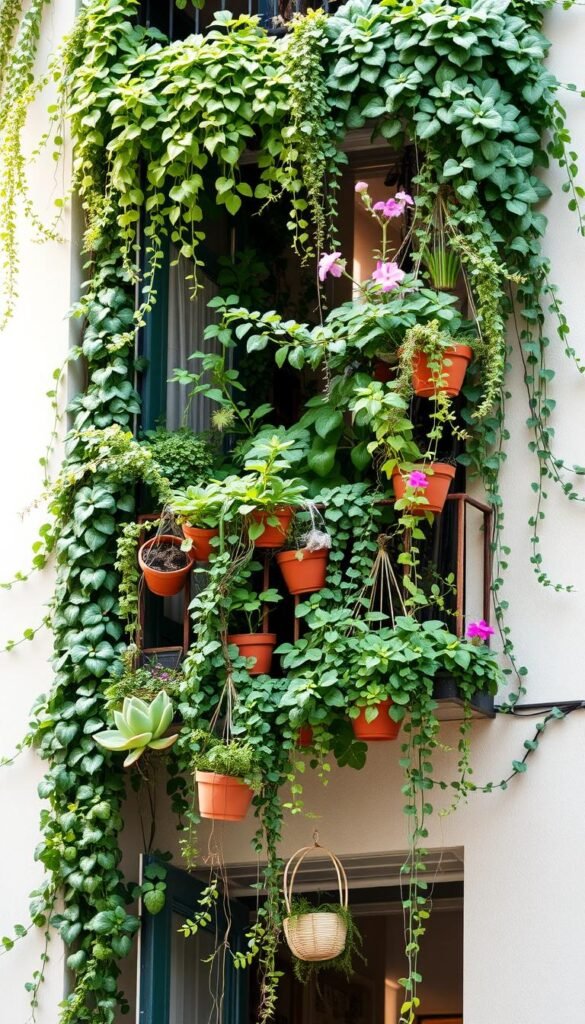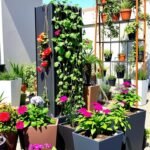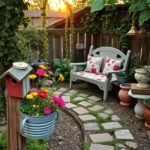What if your 12 ft x 10 ft patio could grow twice as many herbs, flowers, and veggies? Urban growers nationwide are discovering how elevated plant systems turn cramped corners into lush oases. By directing growth upward, you bypass ground limitations while creating stunning green displays.
This approach isn’t just pretty – it’s practical. Trellises and modular planters reduce bending for weeding by 60% compared to traditional beds, according to urban farming studies. Better air circulation around leaves means healthier tomatoes and fewer fungal issues. Even a basic fence-mounted planter can yield 15-20 pounds of strawberries each season.
We’ve seen creative examples like repurposed wooden pallets becoming mint gardens and window boxes overflowing with basil. One Denver resident transformed their balcony into a salad factory using $35 worth of hanging grow bags. Whether you choose DIY projects or sleek commercial systems, the key lies in strategic vertical arrangements.
This guide walks through budget-friendly techniques that work for renters and homeowners alike. You’ll learn how to select plants that thrive when lifted off the ground, position structures for optimal sunlight, and combine functionality with visual charm. Let’s help your green ambitions reach new heights – no sprawling yard required.
Understanding Vertical Gardening in Small Spaces
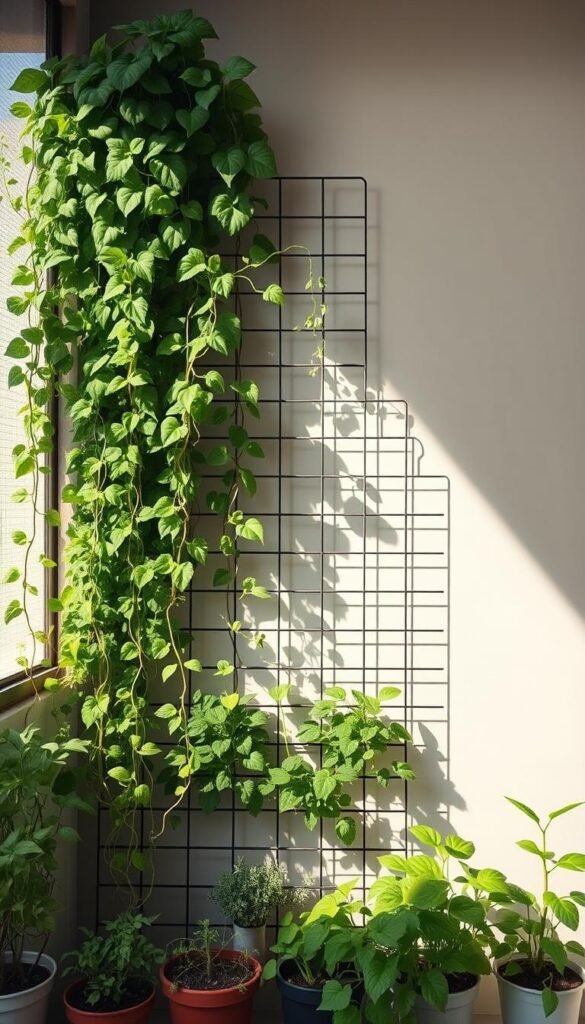
Imagine transforming blank walls or unused fence lines into vibrant green zones bursting with fresh produce. This is the magic of growing upward – a method that turns overlooked areas into productive plant zones without sacrificing floor space.
What Is Vertical Gardening?
Vertical gardening means using structures like trellises, hanging pots, or wall-mounted systems to grow plants upward instead of outward. It’s perfect for patios, balconies, or narrow yards where ground space is limited. For example, cucumbers and pole beans naturally climb supports, while herbs like thyme thrive in stacked planters.
Key Benefits for Your Outdoor Space
This approach offers practical perks beyond saving room. Plants lifted off the ground enjoy better airflow, which reduces mold and mildew. You’ll also notice fewer pests – slugs and rabbits can’t reach elevated greens. Maintenance becomes easier too, with less bending for watering or pruning.
Studies show vertical setups can lower soil-borne diseases by 40% compared to traditional beds. One gardener in Austin doubled her tomato harvest using a simple fence-mounted trellis system, while a Chicago couple grows enough salad greens in window-mounted planters to supply their family all summer.
For those starting out, budget-friendly vertical gardening methods like repurposed shoe organizers or ladder shelves make the transition simple. Whether you’re growing flowers or veggies, this smart strategy lets you work with your available area – not against it.
Innovative Vertical Add-Ons: Expand Your Small Space Garden Upwards
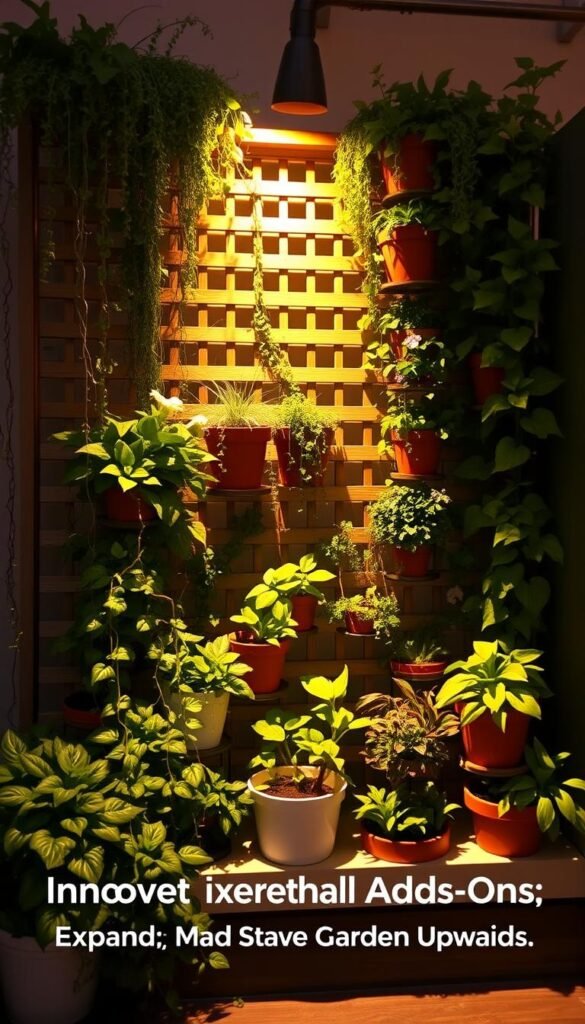
Maximize every inch by blending form and function in your growing area. Clever arrangements turn ordinary walls into living art galleries while boosting your harvest potential. Let’s explore smart tools that merge practicality with eye-catching designs.
Smart Planter Designs for Elevated Growth
Modern planters come in shapes that hug walls or stack like building blocks. Fabric pocket systems let you grow 18 herbs in 4 square feet – perfect for kitchens or balconies. A Seattle gardener used interlocking ceramic pots to create a cascading flower display that doubles as a privacy screen.
Repurposed materials shine here. Old gutters become strawberry runners, while wooden crates mounted on metal brackets host lettuce varieties. For secure setups, use marine-grade twine through drainage holes. One creative twist: hang mason jars with succulents using colorful jute ribbons.
Wall Systems That Work Harder
Trellises aren’t just for vines anymore. Combine them with hanging baskets to create layered displays. A Phoenix homeowner grew 30 pounds of cherry tomatoes using a grid-style metal trellis with clip-on planters. These systems take under two hours to install and cost less than pre-made vertical gardens.
| System Type | Materials | Setup Time | Cost Range |
|---|---|---|---|
| Modular Planters | Recycled plastic | 45 mins | $25-$80 |
| Wall Trellis | Powder-coated steel | 90 mins | $60-$150 |
| Hanging Grid | Weatherproof fabric | 30 mins | $40-$75 |
Pair climbing beans with ornamental vines on shared poles for dual-purpose beauty. Remember: lightweight containers need sturdy clips. Test structures by gently tugging – they should hold firm against summer breezes. These solutions prove that limited ground space can’t limit your green ambitions.
Creative DIY Solutions for Vertical Gardens
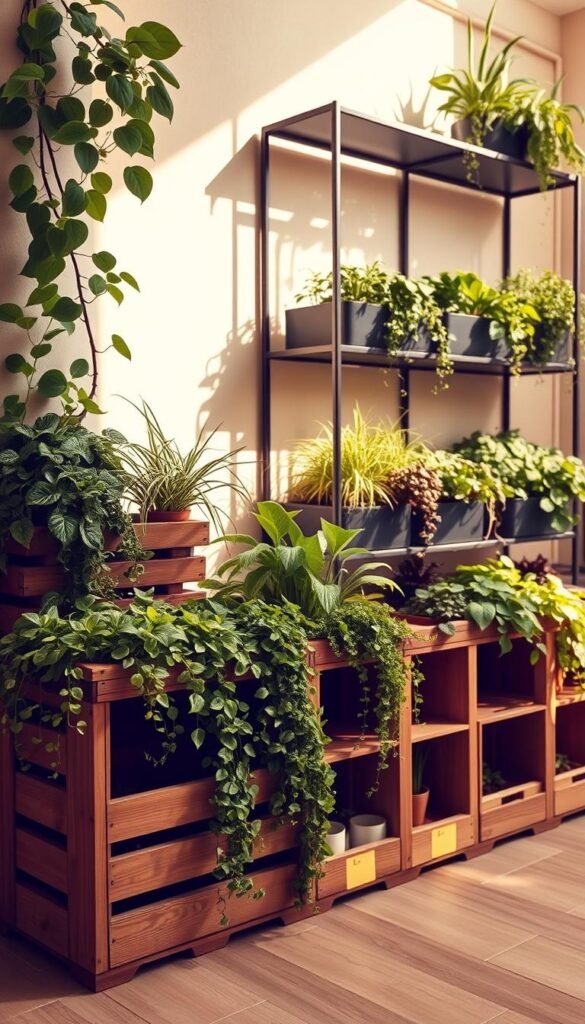
Got a tight corner that needs greenery? Turn everyday items into thriving plant displays with clever upcycling. These wallet-friendly projects transform unused areas into productive zones in under an hour.
Crafting Custom Grow Bags
Breathable fabric bags prevent root rot better than plastic pots. You’ll need burlap sacks or canvas remnants (12″x18″ works best). Fold the material into pockets, stitch three sides, and reinforce with marine-grade twine. Pre-soak soil before filling to help plants establish faster.
Repurposing Household Containers
Old coffee cans become rustic herb homes with simple upgrades:
- Drill drainage holes in the base
- Wrap exterior with jute ribbon
- Hang using S-hooks from a rod
| Material | Prep Time | Cost | Best For |
|---|---|---|---|
| Wooden Crates | 20 mins | $0-$5 | Leafy greens |
| Plastic Bottles | 15 mins | Free | Strawberries |
| Mason Jars | 10 mins | $3-$8 | Succulents |
A Boston apartment dweller grew 14 basil plants in repurposed rain gutters along their fire escape. Total cost? $12 for brackets and soil. These ideas prove you don’t need fancy gear to grow food creatively.
Most projects require basic tools like scissors and a drill. Start small – even five upcycled containers can yield fresh herbs weekly. Your patio or balcony becomes a personalized produce section without the supermarket markup.
Optimizing Space with Vertical Garden Tools and Techniques
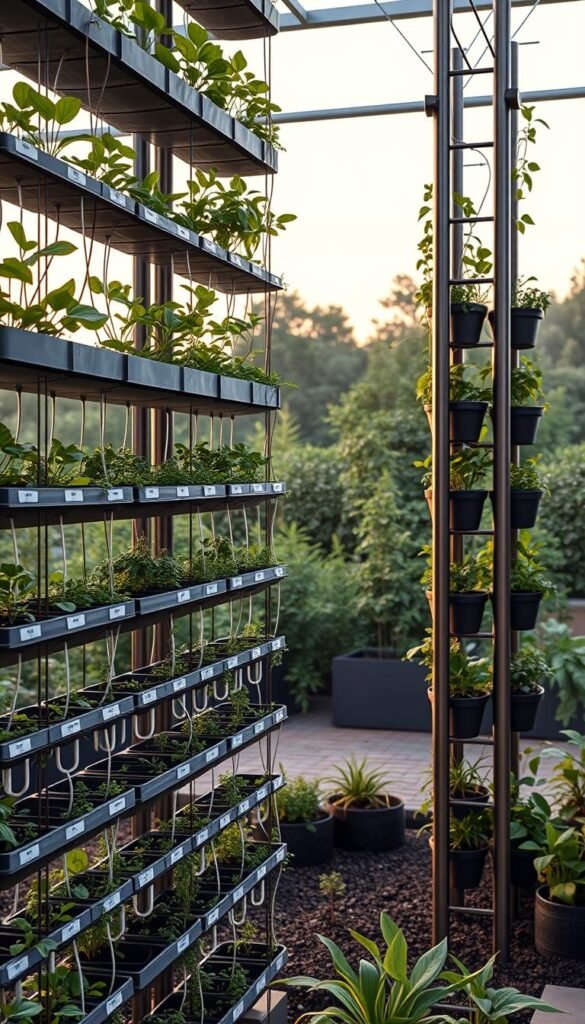
Smart watering and harvesting methods keep your elevated setup thriving. Let’s explore how to maintain lush growth while saving time and effort.
Efficient Irrigation and Maintenance Strategies
Drip systems cut water waste by 50% compared to hand-watering. Use adjustable emitters to target thirsty plants like tomatoes. Connect a timer for hassle-free care – you’ll need just 15 minutes weekly for checks.
| Irrigation Type | Water Savings | Install Time | Best For |
|---|---|---|---|
| Soaker Hoses | 30% | 20 mins | Herb Walls |
| Micro-Sprinklers | 45% | 45 mins | Fruiting Plants |
| Self-Watering Pots | 60% | 5 mins | Leafy Greens |
Check soil moisture with your finger – damp, not soggy. Clean debris from drainage holes monthly to prevent clogs. A Brooklyn gardener reduced mildew by spacing planters 8 inches apart for better airflow.
Ergonomic Harvesting and Airflow Tips
Position frequently picked crops at chest level. This simple shift cuts back strain by 70% during harvests. Rotate planters every two weeks so all sides get equal sun exposure.
Use these spacing guidelines:
| Plant Type | Ideal Height | Air Gap |
|---|---|---|
| Herbs | Eye Level | 6-8″ |
| Peppers | Waist Level | 10-12″ |
| Flowers | Overhead | 4-6″ |
Prune lower leaves weekly to boost circulation. Install breathable fabric panels behind planters if walls trap heat. These tweaks help grow food efficiently while keeping maintenance manageable.
Selecting the Right Plants for Your Vertical Garden
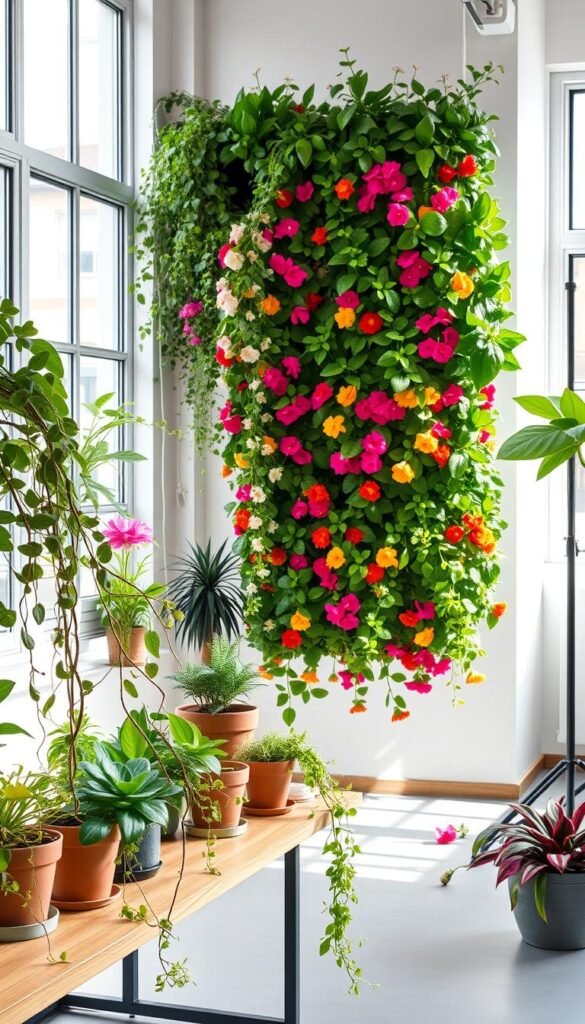
Choosing the perfect greenery turns your elevated setup into a thriving ecosystem. Focus on species that naturally reach skyward or adapt well to confined roots. Their growth patterns should match your structure’s strength and sunlight access.
Climbing Vegetables and Vines That Thrive
Pick crops with grasping tendrils or twining stems. Pole beans scale trellises rapidly, producing 2-3 times more pods than bush varieties. Cucumbers develop straighter fruits when grown vertically, while indeterminate tomatoes need sturdy 6-foot supports. These plants excel with:
- At least 6 hours of daily light
- Moist, well-draining soil mixes
- Secure anchoring points
Urban gardeners report 40% higher yields from vertical climbing vegetables compared to ground planting. Train vines early using soft plant ties to guide growth.
Herbs and Low-Maintenance Ornamental Options
Compact root systems make basil and thyme ideal for stacked planters. Mint spreads aggressively, so contain it in separate pockets. Pair edible herbs with flowering annuals like petunias for pollinator appeal. Key considerations:
| Plant Type | Soil Depth | Light Needs |
|---|---|---|
| Leafy Greens | 6-8″ | Partial Sun |
| Succulents | 4-6″ | Full Sun |
| Ferns | 8-10″ | Shade |
Use lightweight potting mixes to reduce structure strain. Rotate containers quarterly for even light exposure. This approach lets you grow food and beauty simultaneously without constant upkeep.
Wrapping Up Your Vertical Garden Journey
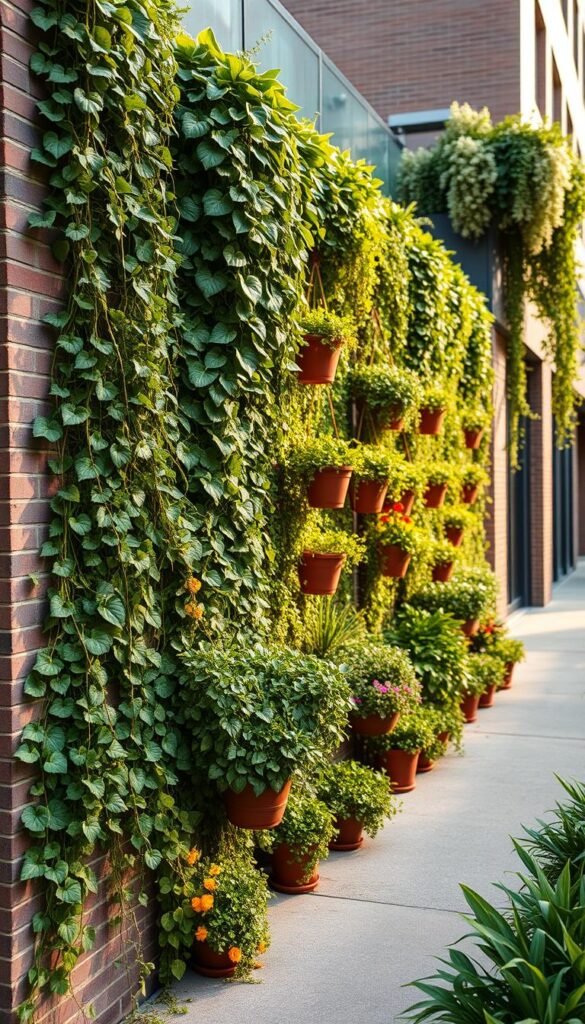
Your journey to a lush, productive garden starts by looking up. Elevating plants unlocks fresh possibilities, whether you’re growing herbs on a balcony or veggies along a sunny wall. The systems we’ve explored – from trellis networks to hanging planters – prove that limited square footage can’t limit your harvests.
Think of your walls and fences as blank canvases. Repurposed containers or modular wall systems let you grow food while adding visual interest. Studies show these setups yield 30-50% more produce than traditional beds, with easier access for watering and pruning.
Ready to transform your space? Start with one project – a pocket herb wall or bean-covered trellis. Many gardeners see results in weeks, like the Chicago couple harvesting salad greens from window-mounted boxes. Lightweight options work for renters, while sturdier systems suit long-term growers.
Remember: success lies in matching plants to your conditions. Prioritize crops that thrive when lifted – leafy greens, compact herbs, and climbing veggies. Pair them with efficient irrigation to save time and water.
Why not start this weekend? Grab some recycled containers or basic brackets. Your future self will thank you when fresh basil garnishes dinners and cherry tomatoes brighten salads. Here’s to reaching new gardening heights – one upward-growing plant at a time!

